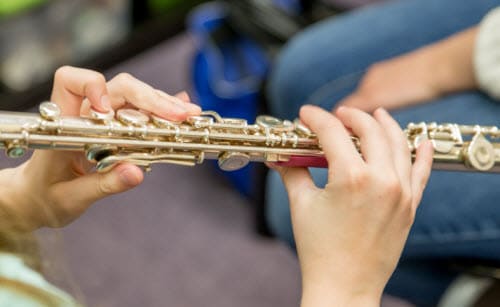
As we continue working towards achieving our annual goals, it’s important to take time and assess where we are in our musical studies. One of the best ways to determine how things are progressing is for students to conduct a regular self-assessment.
“Self Assessment is a useful tool in the artistic process by delineating progress towards goals.” – Kennedy Center Arts Edge
“Observation is the crucial first step.” Creating a recording of yourself practicing or even performing a piece allows the student the opportunity to watch themselves. The observation invites student to notice aspects of their playing that that can’t see otherwise. To increase awareness, create recordings on a regular basis and perform a self-assessment. This intentional practice will create an understanding of where a student is in relation to the goals they have set for themselves.
An article from The Kennedy Center Arts Edge shared the following:
“Self-Assessment offers a number of benefits to student artists. First, it encourages them to understand their own learning. Second, it can increase student motivation and ownership over their own learning. Even the youngest students can self-assess meaningfully as long as it is taught in developmentally appropriate ways (Bindham, Holbrook, & Meters, 2010). And Lastly, self-assessment contributes to student artistic autonomy.” Music teachers have found that self-assessment leads to musical independence and an ability to make self-correction as well as begin to accurately judge the quality of their playing. (Hale & Green, 2009).
Suggested Questions for conducting a Self-Assessment using a video recording:
- Make the recording on a device that is easy for the student to manipulate for multiple viewings.
- Watch the recording one time through just to enjoy it and celebrate all that you’ve learned.
- Watch the video again, listening for note accuracy. Did you notice any passages that need more practice? Write that down.
- Watch the video again, listening for musical expression: tempo, dynamics, articulation. How did these things work together to create an interesting piece of music?
- Watch the video again looking for technique. Are there passages that need more work? What do you need to do to make them better? What specific things can you do in practice to make improvements.
- Watch the video again. Look at your hands and arm position. Next Look at your shoulders. Look at your arm position. Notice your feet. Finally, look at the shape of your mouth (especially if you performing on anything other than piano). What are you doing with body position that is contributing to a good technique and beautiful sound. What might you tweak to improve the sound or technique?
- Watch the video again, then time looking at posture and facial expression. What did you notice? Would you change anything? Write down a few thoughts. Are you slouching or standing tall? Is facial expression pleasant or do you have a look of confusion or pain on your face? All of these factors contribute to the musical presentation.
- Now summarize what you’ve learned. Consider writing it in these terms:
- What would you KEEP doing? Celebrate the success.
- What would you STOP doing? How can you make these adjustment?
- What would you like to START doing? How can you change your practice to make this a reality.
Next steps – Share the result of your self-assessment with your teacher and ask for input. Work together to utilize strategies during practice and lessons that will move students closer to their musicianship goals. We’ve included a worksheet that you can download and use for your next assessment: kathysmusic_selfassessworksheet
Keep all of your video recordings stored in a safe place with easy access. As time goes on and you continue your musical study, take time to watch the videos you’ve created starting with the first one through the most recent. Celebrate the progress that you are making because of your determination and commitment to practice.
Commit to adding to this library of recordings as part of your musical study. Self-assessment is one of the best tools for students and yet it’s likely the one most underutilized.
Credit: All quotes from this article are taken from https://artsedge.kennedy-center.org/educators/how-to/tipsheets/self-assessment.

Leave a Reply